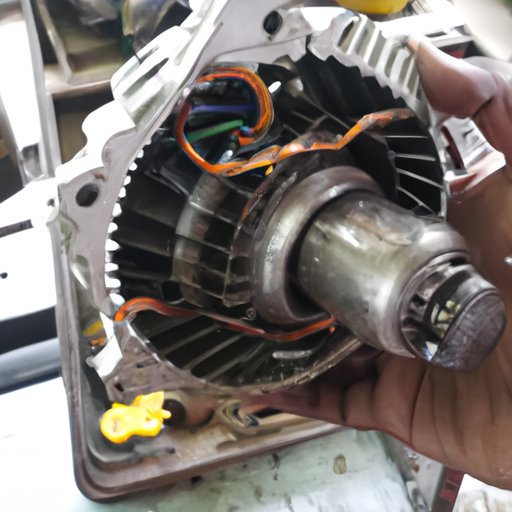Introduction
An alternator is a device that converts mechanical energy into electrical energy. It is typically used in vehicles to create the power needed to operate various accessories, such as the headlights, radio, and other electrical components. In this article, we will be exploring how an alternator works and the science behind it.
Step-by-Step Explanation of How an Alternator Works
The basic principle of an alternator is simple: it uses a rotating magnet to generate an alternating electric current. The alternator has two main parts: the stator and the rotor. The stator is a stationary part of the alternator that is connected to the engine; it contains coils of wire that are wound around iron cores. The rotor is a rotating part of the alternator; it contains an electromagnet that spins inside the stator. As the engine runs, the rotor spins and generates a magnetic field. This magnetic field induces an electric current in the coils of the stator, creating an alternating current.

Exploring the Components of an Alternator and How They Function
An alternator has several key components which work together to generate electricity. The first component is the rotor, which is the spinning part of the alternator. It consists of a core made of iron, around which copper wire is wound. When the engine is running, the rotor spins and creates a magnetic field. This magnetic field then induces an electric current in the stator, which is the second component of the alternator.
The stator is a stationary part of the alternator which is connected to the engine. It consists of a series of coils of wire which are wound around iron cores. When the rotor spins, it creates a magnetic field which induces an electric current in the stator. The stator then sends this electric current to the rectifier, which is the third component of the alternator.
The rectifier is a device which converts the alternating current produced by the stator into direct current. It does this by using diodes, which allow electric current to flow in one direction only. The rectifier then passes the direct current to the battery, which stores the energy for later use.
The Science Behind Alternators: How It Generates Electricity
Generating electricity with an alternator is based on the principle of electromagnetic induction. This principle states that when a conductor (such as a coil of wire) is placed in a changing magnetic field, an electric current is induced in the conductor. This is the same principle that is used in transformers and generators.
In an alternator, the changing magnetic field is created by the spinning rotor. As the rotor spins, it creates a magnetic field which induces an electric current in the stator. The stator then sends this electric current to the rectifier, which converts it into direct current. This direct current is then sent to the battery, which stores the energy for later use.
Unpacking the Mechanics of an Alternator: What Makes It Tick?
The mechanics of an alternator are quite simple. The rotor is connected to the engine and spins at a constant speed. As the rotor spins, it creates a magnetic field which induces an electric current in the stator. The stator then sends this electric current to the rectifier, which converts it into direct current. This direct current is then sent to the battery, where it is stored for later use.
The alternator also contains a voltage regulator, which regulates the amount of voltage that is sent to the battery. This ensures that the battery does not become overcharged or undercharged, which can cause damage to the battery. The voltage regulator also helps to maintain a steady voltage in the electrical system, which helps ensure that all electrical components are operating efficiently.

Common Problems With Alternators and How to Diagnose and Fix Them
Alternators can experience a variety of issues that can cause them to malfunction. Common problems include worn or faulty bearings, loose connections, and a defective voltage regulator. To diagnose these problems, it is important to check the alternator’s output voltage and amperage. If the voltage or amperage is too low, it could indicate a problem with the alternator.
If the voltage or amperage is too high, it could indicate a problem with the voltage regulator. To fix these problems, it is important to replace any worn or damaged components, tighten any loose connections, and replace the voltage regulator if necessary. It is also important to keep the alternator clean and free of debris, as dirt and grime can interfere with its functioning.
Conclusion
In conclusion, an alternator is a device that converts mechanical energy into electrical energy. It works by using a rotating magnet to generate an alternating electric current, which is then converted into direct current by the rectifier. The direct current is then sent to the battery, where it is stored for later use. By understanding how an alternator works, you can diagnose and fix common problems with your vehicle’s electrical system.
(Note: Is this article not meeting your expectations? Do you have knowledge or insights to share? Unlock new opportunities and expand your reach by joining our authors team. Click Registration to join us and share your expertise with our readers.)
